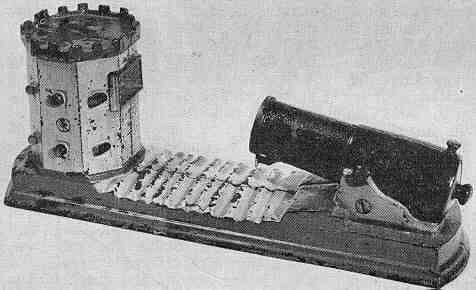Octagonal Fort Bank
by F.H. Griffith - HOBBIES Magazine - August, 1954

Cannons and guns always have a certain fascination for men and boys. Therefore, it is quite natural that the mechanical bank designers and manufacturers would take advantage of this fact and produce a number of different banks using a cannon or gun. A number of the banks using guns are rather common, such as the Creedmore, William Tell, and the Indian and the Bear. Rare examples having a gun are the Sportsman’s Bank and the Lion Hunter. The most common of the banks having a cannon is the Artillery Bank, and among the rarest having a cannon is the Octagonal Fort Bank, No. 31 in our numerical classification.
The bank shown is in excellent original condition with fine paint and no broken or missing parts. It was obtained recently through the good help of J.E. Nevil of Cincinnati, Ohio. Even though the bank is an unusually heavy casting it was apparently subject to easy breakage as any other specimens ever seen by the writer had some parts broken off. Also the paint was usually in bad shape.
The painting of the bank is a little unusual in that it was first painted entirely black and then the other colors applied. These other colors tend to flake and chip off the black base paint with any degree of rough handling. The colors are very attractive, the base being green and the water light green with white capped waves. The cannon is black with a red base and the fort is gray with brown top and bottom. The cannons protruding from the fort are black with red tipped ends.
The operation of the bank is as follows: A coin is inserted in the end of the cannon barrel, then the lever underneath the end of the barrel is pushed back and it clicks into a locked position. The firing knob at the top of the breach of the cannon is then pressed and the coin is fired into the fort.
Factual background is a real scarcity in the case of the Octagonal Fort Bank. The actual designer and manufacturer are not known. There are no patent papers covering the bank and there are no identifying marks on the bank itself that would be characteristic of any particular manufacturer or designer. There are, however, certain clues to its possible identity and time of manufacture.
In the first place, this bank is apparently a Civil War commemorative item. The fort is octagonal shaped and there is water represented on the bank between the fort and the cannon. This would lead to Fort Sumter and the firing of the first shot in the Civil War. The cannon is of the type that can be seen in Charleston, S.C., today.
Now to the possible source and time of manufacture of the bank. During the 1880’s a toy salesman, Major Edward Brueninghausen, sold banks and toys which he had specially manufactured for his trade. He was a Civil War veteran and had entered the toy business around 1875. It’s very possible that the Octagonal Fort, as well as a number of the other untraceable banks, were manufactured for and sold by Major Brueninghausen.
In any event, until such time that refutable evidence might turn up it’s logical that the Octagonal Fort Bank represents Fort Sumter, was made in the period of 1880, and was sold by Brueninghausen.
Just what name the bank was originally sold under is not known. To the best of the writer’s knowledge there have been no old catalogs or similar type of material found that pictured or described the bank. Octagonal Fort is a good descriptive name and easily identifies it from any of the other mechanical banks.
The number of Octagonal Fort Banks in private collections is quite limited and those possessing one are very fortunate.
